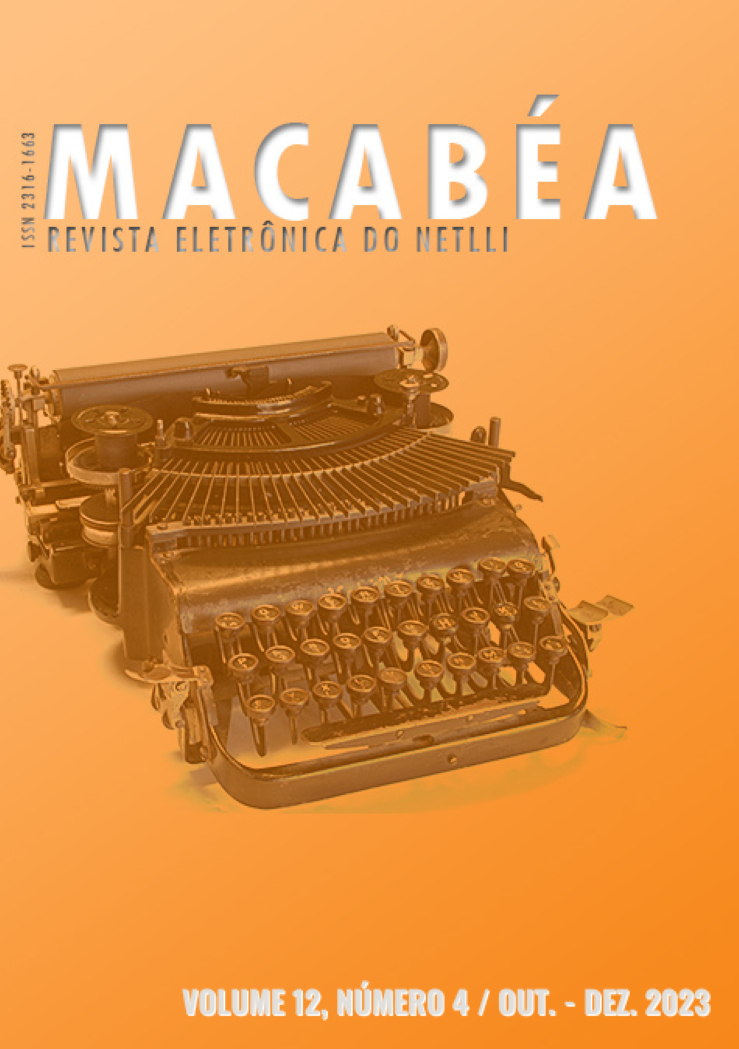DISCOURSE AND MALE DOMINATION IN A SEQUEL OF ROSEMARY'S BABY (1968)
DOI:
https://doi.org/10.47295/mren.v12i4.1356Keywords:
Gender relations, Critical Discourse Analysis, Systemic-Functional Grammar, Grammar of Visual DesignAbstract
The aim of this research is to analyze a sequel of the American horror film Rosemary's Baby (1968) released by Paramount Pictures with a focus on gender relations. The theoretical framework of the research is anchored in the studies of Critical Discourse Analysis (FAIRCLOUGH, 2003; 2016), Systemic Functional Linguistics (HALLIDAY; MATTHIESSEN, 2014) and The Grammar of Visual Design (KRESS; van LEEUWEN, 2021). The methodology can be seen through three dimensions: the first, linguistic, supported by the Ideational metafunction of Systemic Functional Grammar; the second, imagery, anchored in the representational function of the Grammar of Visual Design; the third, macro analysis, supported by the concepts of ideology, hegemony, and male domination. The findings indicate that, in the sequence analyzed, we find an attempt by the character Sapirstein, a doctor in the film, to control his patient Rosemary, the film's protagonist, through a social control based on gender relations.
References
BARROS, S. M. Bases filosóficas de análise de discurso crítica. In: BATISTA JUNIOR et al. Análise de Discurso Crítica para linguistas e não linguistas. São Paulo: Parábola, 2018. p. 36-47.
BATISTA JUNIOR et al. Análise de Discurso Crítica para linguistas e não linguistas. São Paulo: Parábola, 2018.
BEASLEY, C. Gender and sexuality: critical theories, critical thinkers. London: Sage publications, 2005.
BEASLEY, C. What is Feminism?: An Introduction to Feminist Theory. London: Sage, 1999.
BOURDIEU, P. A dominação masculina. 18. ed. Rio de Janeiro: Editora Bertrand Brasil, 2020.
BOURDIEU, P. Sociologia. São Paulo: Ática, 1983.Editora Vozes, 1983.
BUTLER, J. Gender trouble. London: Routledge, 2007.
CARMO, C. M. O lugar da cultura nas teorias de base linguística sistêmico-funcional. Curitiba: Editora Annris, 2014.
CARRIGAN, T. et al. Toward a new sociology of masculinity. In: MURPHY, P. M. Feminism and masculinities. New York: Oxford University Press., 2004.
CONNELL, R.; PEARSE, R. Gênero: uma perspectiva global. São Paulo: Nversos, 2015.
CUNHA, M. A. F.; SOUZA, M. M. Transitividade e seus contextos de uso. São Paulo: Cortez, 2011.
FAIRCLOUGH, N. Analysing discourse: textual analysis for social research. Londres: Routledge, 2003.
FAIRCLOUGH, N. Discurso e mudança social. 2. ed. Brasília: Editora Universidade de Brasília, 2016.
FERRO, M. Cinema e História. Rio de janeiro: Paz e terra, 1992.
GRAMSCI, A. Cadernos do cárcere, volume 1. Rio de Janeiro: Civilização Brasileira, 1999.
HALLIDAY, M. A. K; MATTHIESSEN, M. I. M. An Introduction to Functional Grammar . 4. ed. Nova York: Routledge, 2014.
HALLIDAY, M. A. K. Language as social semiotic: the social interpretation of language and meaning. London: Edward Arnold, 1978.
KRESS, G.; VAN LEEUWEN, T. Reading images: the grammar of visual design. 3 ed. London: Routledge, 2021.
MATTHIESSEN, C. M. I. M., TERUYA, K.; LAM, M. Key terms in Systemic Functional-Linguistics. New York: Continuum International Publishig Group, 2010.
PEREIRA, A. S.; TEIXEIRA, L. M. S.; PEREIRA, R. S. Discurso. In: IRINEU, L. M et al. Análise de discurso crítica: conceitos-chave. Campinas: Pontes editores, 2020. p. 25-44.
ROSEMARY’S BABY. Direção: Roman Polanski. Produção de William Castle. Estados Unidos: Paramount Pictures, 1968. DVD.
SILVA, F. D. B.; MAIA, K. W. M.; MULLER, R. G. Hegemonia. In: IRINEU, L. M et al. Análise de discurso crítica: conceitos-chave. Campinas: Pontes editores, 2020. p. 85-106.
SOARES, L. A. A análise do discurso fílmico sob a perspectiva textual-linguística e multimodal. Revista da Abralin, v. 20, n. 2, p. 1-26, 2021.
TAPPER, M. Can a feminist be a liberal? Australasian Journal of Philosophy, Supplement to vol. 64, 1986.
THOMPSON, J. B. Ideologia e cultura moderna: teoria social crítica na era dos meios de comunicação de massa. Petrópolis: Editora Vozes, 2002.
van DIJK, T. Discourse and knowledge: a sociocognitive approach. Cambridge:
WILDFEUER, J. Film discourse interpretation: towards a new paradigm for Multimodal Film Analysis. Nova York: Routledge, 2016.
Downloads
Published
How to Cite
Issue
Section
License
Copyright (c) 2023 Altair dos Santos Bernardo Júnior

This work is licensed under a Creative Commons Attribution-NonCommercial-ShareAlike 4.0 International License.
Autores que publicam nesta revista concordam com os seguintes termos:
a. Autores mantém os direitos autorais e concedem à revista o direito de primeira publicação, com o trabalho simultaneamente licenciado sob a Licença Creative Commons Attribution que permite o compartilhamento do trabalho com reconhecimento da autoria e publicação inicial nesta revista.
b. Autores têm autorização para assumir contratos adicionais separadamente, para distribuição não-exclusiva da versão do trabalho publicada nesta revista (ex.: publicar em repositório institucional ou como capítulo de livro), com reconhecimento de autoria e publicação inicial nesta revista.
c. Autores têm permissão e são estimulados a publicar e distribuir seu trabalho online (ex.: em repositórios institucionais ou na sua página pessoal) a qualquer ponto antes ou durante o processo editorial, já que isso pode gerar alterações produtivas, bem como aumentar o impacto e a citação do trabalho publicado (Veja O Efeito do Acesso Livre).










